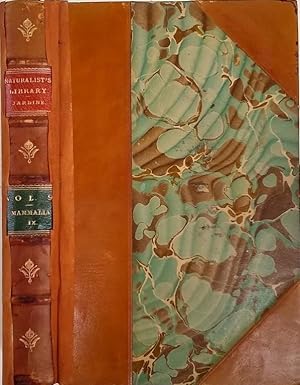smith lieut col charles hamilton (1 Ergebnisse)
Produktart
- Alle Product Types
- Bücher (1)
- Magazine & Zeitschriften
- Comics
- Noten
- Kunst, Grafik & Poster
- Fotografien
- Karten
- Manuskripte & Papierantiquitäten
Zustand
- Alle
- Neu
- Antiquarisch (1)
Einband
- alle Einbände
- Hardcover (1)
- Softcover
Weitere Eigenschaften
- Erstausgabe (1)
- Signiert
- Schutzumschlag
- Angebotsfoto (1)
Gratisversand
- Versand nach USA gratis
Land des Verkäufers
Verkäuferbewertung
-
The Natural History of Dogs. Canidae or Genus Canis of Authors. Including also the Genera Hyaena and Proteles. Vol. 1.
Verlag: W. H. Lizars, 1839., Edinburgh:, 1839
Anbieter: Jeff Weber Rare Books, Montreux, VAUD, Schweiz
Erstausgabe
Series: The NaturalistâÂÂs Library. Mammalia. Vol. IX. Sm. 8vo. xiv, [2], [17]-267, [1] pp. Engraved frontispiece portrait of Pallas, series title-page vignette showing the dogs of "Mr. St Bernard," 30 hand colored plates and 5 black and white plates (of dog skulls) [the plates are numbered 1-34, the final plate is not numbered], includes Memoir of Pallas, appendix; pp.103-4 bottom margin torn away (missing, not affecting main text). Original half calf over marbled paper, gilt spine, red and green morocco spine labels, and five raised spine bands, t.e.g., marbled endpapers; front joint crack mended with Japanese Kozo paper, otherwise very good. First edition. This volume covers wild dogs, including wolves and foxes. "Lieutenant-Colonel Charles Hamilton Smith (1776-1859) was an English artist, naturalist, antiquary, illustrator, soldier, and spy. His military career began in 1787, when he studied at the Austrian academy for artillery and engineers at Mechelen and Leuven in Belgium. Although his military service, which ended in 1820 and included the Napoleonic Wars, saw him travel extensively (including the West Indies, Canada, and United States), much of his time was spent at a desk job in Britain. One of his noteworthy achievements was an 1800 experiment to determine which colour should be used for military uniforms. The increasing accuracy of firearms, especially rifles, brought advantages to shades which offer a less distinctive target - by testing the accuracy of a rifle company against grey, green, and red targets, he showed scientifically the advantages of grey (and to a lesser extent, green) uniforms over red ones common at the time, and recommended that grey be adopted for riflemen and light infantry. The British army did not heed his advice, with green becoming the colour associated with light infantry. Initially commissioned into the 60th Foot, Smith later transferred to the 6th Foot. As a prolific self-taught illustrator, he is also known in military history circles for Costume of the Army of the British Empire, produced towards the end of the Napoleonic Wars and an accurate depiction of contemporary British uniform. As an antiquarian, he also produced, in collaboration with Samuel Rush Meyrick, Costume of the Original Inhabitants of the British Islands, 1815, and The Ancient Costume of England, with historical illustrations of medieval knights, ladies, ships and battles. The majority of his vast body of work (he estimated it was over 38,000 drawings) was not military in character, but largely passed into obscurity. Notebooks of his observations as a naturalist have survived, as well as antiquarian illustrations of civilian life. He also wrote on the history of the Seven Yearsâ War and the NATURAL HISTORY OF DOGS. Smith was of Flemish origin; he wrote the military part of CoxâÂÂs Marlborough and many military and natural history books." - Wikip.


